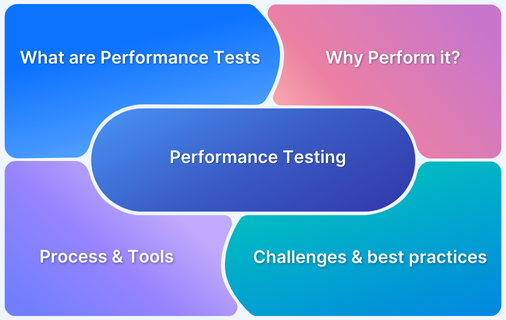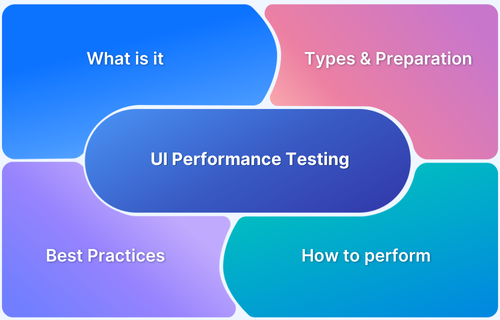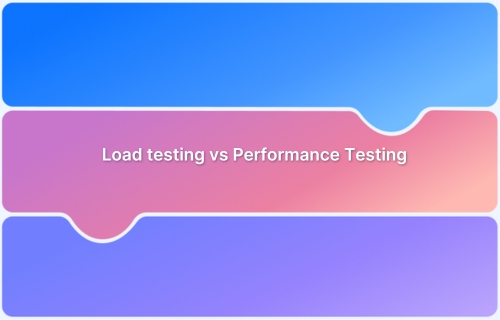Are you struggling to ensure your app performs under pressure?
Users expect seamless performance across devices and environments. A poorly performing app can lead to user drop-offs, revenue loss, and brand damage.
In fact, a 1-second delay in page load time can decrease conversions by up to 7%. That’s why automation in performance testing is crucial—it helps ensure your app remains scalable, stable, and responsive even during rapid release cycles and complex systems.
Overview
Why Perform Automated Performance Test?
- Scales to simulate thousands or millions of users
- Ensures consistent results by eliminating human error
- Runs workloads faster, saving testing time
- Detects performance bottlenecks early in development
- Enables continuous validation in CI/CD workflows
- Lowers costs by reducing manual effort and post-release fixes
To keep up with rapid release cycles and complex systems, organizations increasingly rely on automation in performance testing to ensure the scalability, stability, and responsiveness of applications.
Understanding the Need for Performance Testing in Software Development
Performance testing assesses how an application behaves under specific conditions, such as high user load, peak traffic, or resource-intensive operations. It goes beyond functional correctness and focuses on non-functional aspects like speed, scalability, and reliability.
Without performance testing, applications risk crashing under unexpected workloads, responding sluggishly to user requests, or creating bottlenecks that degrade user experiences. Common goals include:
- Identifying system bottlenecks under load.
- Ensuring stability during peak usage.
- Validating response times and throughput.
- Benchmarking performance against service-level agreements (SLAs).
What is Automated Performance Testing?
Automated performance testing uses scripts and tools to simulate real-world workloads and measure how an application behaves under these conditions. Instead of manually generating traffic and monitoring results, automation frameworks execute performance scenarios consistently, collect data, and generate actionable reports.
For example, in an e-commerce application, automated performance tests might simulate thousands of users searching for products, adding them to carts, and checking out simultaneously, while tracking response times and system stability.
Read More: Performance Testing Vs Load testing
Why Automate Performance Testing? Key Benefits
Manual performance testing is limited in scalability and consistency. Automating the process offers significant advantages:
- Scalability: Simulates thousands or millions of users concurrently.
- Consistency: Repeats tests with identical conditions, eliminating human error.
- Speed: Executes complex workloads faster, reducing testing time.
- Early detection: Identifies bottlenecks during development instead of post-release.
- Integration with DevOps: Supports continuous performance validation in agile and CI/CD workflows.
- Cost-effectiveness: Minimizes operational costs by reducing manual effort and catching issues early.
Key Performance Metrics to Focus On in Automation
Automated performance testing should track measurable indicators to assess system health:
- Response time: Time taken by the system to respond to a request.
- Throughput: Number of transactions handled per second.
- Latency: Delay between a request and the system’s response.
- Error rate: Percentage of failed requests under load.
- Scalability: System’s ability to maintain performance as user load increases.
- Resource utilization: CPU, memory, disk, and network usage during tests.
Read More: Guide to UI Performance Testing
Challenges in Adopting Automated Performance Testing
Despite its benefits, organizations face hurdles when adopting automation for performance testing:
- High setup cost: Initial investment in tools, infrastructure, and expertise can be significant.
- Complex test environments: Accurately replicating production conditions can be challenging.
- Data management: Creating and maintaining realistic datasets for performance scenarios is complex.
- Test flakiness: Network latency and dynamic conditions can create inconsistent results.
- Integration challenges: Aligning performance tests with CI/CD pipelines requires robust frameworks and processes.
Top Automation Tools for Performance Testing
Here are some popular tools to consider for automated performance testing:
BrowserStack Automate
BrowserStack Automate provides cloud-based infrastructure for running automated tests, including performance scenarios, on over 3500+ real device-browser combinations. It enables teams to test in production-like environments without managing physical devices.
Key Features:
- Run Playwright automation across 3,500+ real desktop and mobile browsers.
- Generate Lighthouse reports during test runs, tracking metrics like First Contentful Paint and Time to Interactive.
- Collect automatic page load performance reports for every session.
- Access network logs, console logs, screenshots, and performance data for in-depth debugging.
- Integrate effortlessly with CI/CD platforms like Jenkins, GitHub Actions, and CircleCI for continuous monitoring.
Apache JMeter
An open-source tool designed for load and performance testing of web and API applications. Widely used due to its flexibility and large community support.
Key Features:
- Supports HTTP, FTP, JDBC, SOAP, and REST protocols.
- Distributed load testing across multiple servers.
- Extensible with plugins and scripting.
- Comprehensive reporting with graphs and dashboards.
Gatling
A performance testing framework built on Scala, Gatling is known for high performance, scalability, and developer-friendly scripting.
Key Features:
- Scenario creation using domain-specific language (DSL).
- Real-time metrics and detailed HTML reports.
- High throughput with minimal resource consumption.
- Integrates with CI/CD pipelines.
Read More: Top 20 Performance Testing Tools
Locust
A Python-based performance testing framework designed for simplicity and scalability. Tests are defined in Python code, making them highly customizable.
Key Features:
- User behavior simulation with Python scripts.
- Distributed and scalable testing.
- Web-based UI for monitoring.
- Lightweight with minimal overhead.
LoadRunner
A commercial performance testing solution offering comprehensive testing capabilities for large enterprises.
Key Features:
- Supports a wide range of protocols and technologies.
- Real-time monitoring and detailed reporting.
- Simulates thousands of virtual users.
- Strong integration with enterprise DevOps ecosystems.
Strategies for Effective Automated Performance Testing
To maximize results, organizations should follow proven strategies:
- Define clear objectives: Align performance tests with business goals and SLAs.
- Test early and often: Incorporate lightweight performance checks during development, not just pre-release.
- Replicate real-world conditions: Simulate realistic user behavior, network latency, and device diversity.
- Use synthetic and production data: Ensure test data closely matches real-world usage patterns.
- Optimize scripts and environments: Regularly update test scripts and environments as applications evolve.
- Leverage parallel testing: Run large-scale scenarios simultaneously to save time.
To optimize your automated performance testing and ensure reliable results, expert guidance is essential.
Get Expert QA Guidance Today
Schedule a call with BrowserStack QA specialists to discuss your testing challenges, automation strategies, and tool integrations. Gain actionable insights tailored to your projects and ensure faster, more reliable software delivery.
Why use BrowserStack for Automated Performance Testing?
Accurate performance testing requires real-world environments, not just simulated conditions. BrowserStack Automate enables teams to test performance across thousands of real devices and browsers hosted in the cloud.
BrowserStack Automate combines the power of Playwright automation with Lighthouse-based performance testing, enabling teams to validate not just functionality but also the speed, stability, and responsiveness of web applications—all on real browsers and devices.
By running tests on BrowserStack’s secure cloud infrastructure, developers and QA teams can capture actionable performance insights without maintaining local setups or infrastructure. From page load times to Lighthouse scores, Automate ensures applications meet modern performance benchmarks while integrating seamlessly into existing CI/CD pipelines.
Key Features and Capabilities
- Comprehensive coverage: Validate application performance across 3,500+ real desktop and mobile browsers to ensure consistency for all users.
- Actionable performance insights: Gain Lighthouse-based reports with key metrics like First Contentful Paint and Time to Interactive during test runs.
- Improved user experience assurance: Automatically generate page load performance reports for every session to catch slowdowns early.
- Faster debugging cycles: Leverage detailed network logs, console logs, screenshots, and performance data to quickly identify root causes.
- Seamless DevOps integration: Continuously monitor performance by integrating with CI/CD tools such as Jenkins, GitHub Actions, and CircleCI.
Compatibility
- Supports major browsers including Chrome, Firefox, Safari, and Edge.
- Works with frameworks like Playwright, Selenium, and more.
- Provides cross-platform coverage on Windows, macOS, Android, and iOS.
Integration
- Enable Lighthouse metrics with a simple flag in Playwright test configuration—no extra setup required.
- Plug into CI/CD systems such as GitHub Actions, Jenkins, GitLab, and Bitbucket.
- Share reports through public URLs or integrate with tools like Slack, JIRA, or custom dashboards via REST API.
Conclusion
Automated performance testing is essential for delivering applications that remain fast, stable, and scalable under diverse conditions. By focusing on the right metrics, adopting proven tools, and integrating tests into CI/CD pipelines, organizations can achieve continuous performance assurance.
Platforms like BrowserStack Automate make it possible to validate performance in real-world environments without the overhead of maintaining infrastructure. With the right approach, automated performance testing becomes a cornerstone of reliable, high-quality software delivery.







